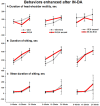Intranasal Dopamine Reduces In Vivo [(123)I]FP-CIT Binding to Striatal Dopamine Transporter: Correlation with Behavioral Changes and Evidence for Pavlovian Conditioned Dopamine Response
- PMID: 27148001
- PMCID: PMC4840254
- DOI: 10.3389/fnbeh.2016.00080
Intranasal Dopamine Reduces In Vivo [(123)I]FP-CIT Binding to Striatal Dopamine Transporter: Correlation with Behavioral Changes and Evidence for Pavlovian Conditioned Dopamine Response
Abstract
Purpose: Dopamine (DA), which does not cross the blood-brain barrier, has central and behavioral effects when administered via the nasal route. Neither the mechanisms of central action of intranasal dopamine (IN-DA), nor its mechanisms of diffusion and transport into the brain are well understood. We here examined whether IN-DA application influences dopamine transporter (DAT) binding in the dorsal striatum and assessed the extent of binding in relation to motor and exploratory behaviors. We hypothesized that, based on the finding of increased extracellular DA in the striatum induced by application of IN-DA, binding of [(123)I]FP-CIT to the DAT should be decreased due to competition at the receptor.
Methods: Rats were administered 3 mg/kg IN-DA and vehicle (VEH), with IN-DA injection either preceding or following VEH. Then motor and exploratory behaviors (traveled distance, velocity, center time, sitting, rearing, head-shoulder motility, grooming) were assessed for 30 min in an open field prior to administration of [(123)I]FP-CIT. DAT binding after IN-DA and VEH was measured with small animal SPECT 2 h following administration of the radioligand.
Results: (1) After IN-DA application, striatal DAT binding was significantly lower as compared to VEH, indicating that the nasally delivered DA had central action and increased DA levels comparable to that found previously with L-DOPA administration; and (2) DAT binding in response to intranasal VEH was lower when IN-DA application preceded VEH treatment. This finding is suggestive of Pavlovian conditioning of DA at the level of the DAT, since the DA treatment modified (decreased) the binding in response to the subsequent VEH treatment. VEH treatment also reduced motor and exploratory behaviors more when applied before, as compared to when it followed IN-DA application, also indicative of behavioral Pavlovian conditioning akin to that found upon application of various psychostimulant drugs.
The results: (a) demonstrate a direct central action of intranasally applied DA on the DAT in the dorsal striatum, indicating enhanced DA availability; and (b) provide first evidence of a Pavlovian conditioned DA response at the DAT. The latter results have relevance to understanding neurochemical mechanisms that underlie placebo action in the treatment of Parkinsonian patients.
Keywords: Pavlovian conditioning; dopamine; dopamine transporter; intranasal administration; placebo; small animal SPECT.
Figures





Similar articles
-
DAT versus D2 receptor binding in the rat striatum: l-DOPA-induced motor activity is better predicted by reuptake than release of dopamine.Synapse. 2016 Sep;70(9):369-77. doi: 10.1002/syn.21911. Epub 2016 May 30. Synapse. 2016. PMID: 27164322
-
Relationship between L-DOPA-induced reduction in motor and exploratory activity and degree of DAT binding in the rat.Front Behav Neurosci. 2014 Dec 17;8:431. doi: 10.3389/fnbeh.2014.00431. eCollection 2014. Front Behav Neurosci. 2014. PMID: 25566000 Free PMC article.
-
Combination of In Vivo [123I]FP-CIT SPECT and Microdialysis Reveals an Antipsychotic Drug Haloperidol-induced Synaptic Dopamine Availability in the Rat Midbrain and Striatum.Exp Neurobiol. 2019 Oct 31;28(5):602-611. doi: 10.5607/en.2019.28.5.602. Exp Neurobiol. 2019. PMID: 31698552 Free PMC article.
-
Pharmacological treatment with L-DOPA may reduce striatal dopamine transporter binding in in vivo imaging studies.Nuklearmedizin. 2016;55(1):21-8. doi: 10.3413/Nukmed-0764-15-08. Epub 2015 Dec 7. Nuklearmedizin. 2016. PMID: 26642370 Review.
-
[The dopamine transporter: characterization and physiopathologic implications].Encephale. 1995 Nov-Dec;21(6):445-51. Encephale. 1995. PMID: 8674469 Review. French.
Cited by
-
Dopamine D2-Subtype Receptors Outside the Blood-Brain Barrier Mediate Enhancement of Mesolimbic Dopamine Release and Conditioned Place Preference by Intravenous Dopamine.Front Cell Neurosci. 2022 Jul 12;16:944243. doi: 10.3389/fncel.2022.944243. eCollection 2022. Front Cell Neurosci. 2022. PMID: 35903367 Free PMC article.
-
Altered dopaminergic pathways and therapeutic effects of intranasal dopamine in two distinct mouse models of autism.Mol Brain. 2020 Aug 10;13(1):111. doi: 10.1186/s13041-020-00649-7. Mol Brain. 2020. PMID: 32778145 Free PMC article.
-
Rapid induction of dopamine sensitization in the nucleus accumbens shell induced by a single injection of cocaine.Behav Brain Res. 2017 May 1;324:66-70. doi: 10.1016/j.bbr.2017.02.018. Epub 2017 Feb 14. Behav Brain Res. 2017. PMID: 28223145 Free PMC article.
References
-
- Aragona B. J., Day J. J., Roitman M. F., Cleaveland N. A., Wightman R. M., Carelli R. M. (2009). Regional specificity in the real-time development of phasic dopamine transmission patterns during acquisition of a cue-cocaine association in rats. Eur. J. Neurosci. 30, 1889–1899. 10.1111/j.1460-9568.2009.07027.x - DOI - PMC - PubMed
LinkOut - more resources
Full Text Sources
Other Literature Sources

